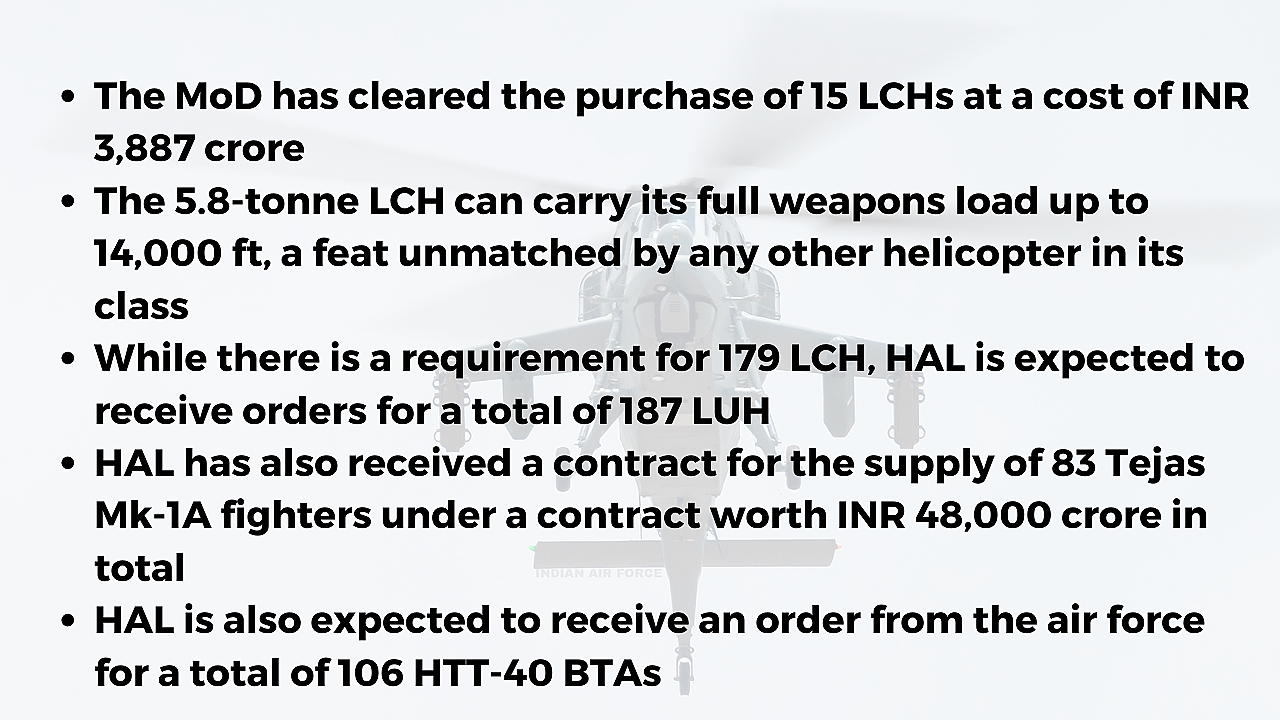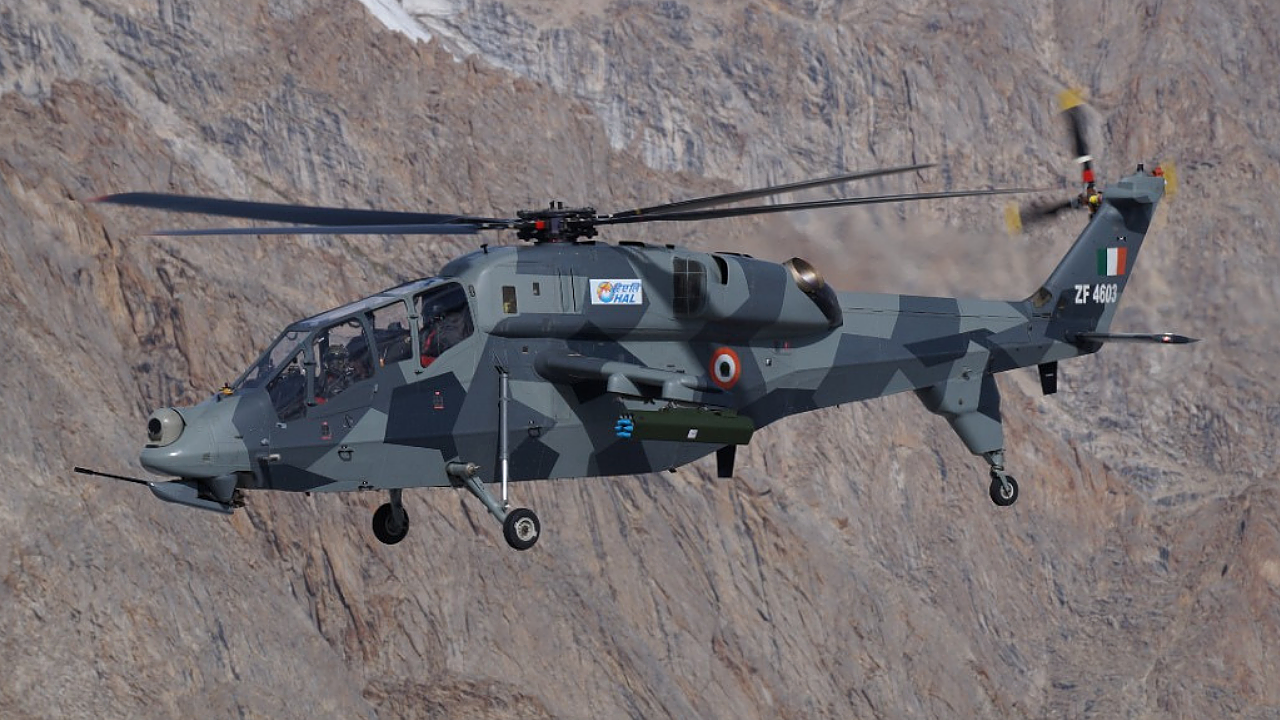
State-owned Hindustan Aeronautics Limited (HAL) is witnessing a renaissance in its indigenous aircraft portfolio with production orders for the Tejas light fighter, Light Combat Helicopter (LCH), Light Utility Helicopter (LUH) and Advanced Light Helicopter (ALH) ‘Dhruv’. The company is now transitioning to a manufacturer of indigenous aircraft and helicopters compared to license production of foreign aircraft (Sukhoi SU-30 MKI, Bae Systems Hawk, Dornier Do-228) as was done earlier.
HAL’s FY22 revenues (provisional and unaudited) amounted to over INR 24,000 crore, a 6% increase over the previous financial year’s revenue of INR. 22,755 crore. As of March 31, 2021, the company’s order book stood at a healthy INR 80,639 crore. In FY20, it had recorded a turnover of INR 21,228 crore. Over the last two years, HAL has produced a total of 88 new aircraft and helicopters and manufactured 186 aircraft engines. It also overhauled 401 aircraft and 984 engines across FY2019-2021.
The aerospace firm is also working on more advanced programmes such as the Tejas MkII Medium Weight Fighter (MWF), Advanced Medium Combat Aircraft (AMCA) and the Indian Multi Role Helicopter (IMRH), to name a few. It has entered into an MoU with the Aeronautical Development Agency (ADA) to design and develop AMCA, a twin-engine multi-role fighter aircraft with 5th generation capabilities developed for the air force. The airframer is also slated to complete the HTT-40 Basic Trainer Aircraft (BTA) development shortly, which will lead to additional orders.
LCH Order Highlights Rotorcraft Potential
On March 30, the Cabinet Committee on Security (CCS), which is led by Prime Minister Narendra Modi, approved the procurement of 15 LCHs at the cost of INR 3,887 crore, along with infrastructure-related activities worth INR 377 crore. The LCH has been indigenously designed and developed by HAL’s Rotary Wing Research & Development Centre (RWRDC) in Bengaluru, and the airframer now joins a select group of aerospace firms worldwide who have designed, developed and productionised an attack helicopter. The 5.8-tonne LCH can carry its full weapons load up to 14,000 ft, making it unmatched amongst helicopters in this class anywhere in the world.
The first batch of 15 helicopters will be built to Limited Series Production (LSP) standard and allow the army and air force to operate them to suggest changes/improvements before the start of Series Production (SP). LSP versions of the LCH will have 45% indigenous content by value, which will progressively increase to greater than 55% for SP versions.

Manufacture of the helicopter will take place at the new Light Combat Helicopter Production Hangar located at Helicopter Division in HAL’s Bengaluru Complex. Defence Minister Rajnath Singh inaugurated the new production facility in February 2020. As per previous plans, the army and air force were to acquire 179 helicopters, and HAL has stated that it will be able to achieve a peak production rate of 30 helicopters annually. Once inducted into the armed forces, the LCH will be expected to remain in service until 2060, at the very least.
In addition to the LCH, HAL has completed the design and development of the 3-tonne LUH, which again offers high-altitude performance unmatched by any helicopter in its class. The LUH will be capable of flying at a speed of 220 kmph, attain a service ceiling of 6.5 km, and offer a range of 350 Km with a 500 kg payload. The army and air force versions of the LUH have already received their Initial Operational Clearance (IOC) certification, which makes them ready to be inducted into the services.
Just as in the LCH programme, the LSP route is being followed to ensure that any glitches/niggles are identified early on by the users to ensure that SP built helicopters offer high operational availability levels. The initial batch of four LSP will be split between the army and air force and manufactured across 2022-2023, while eight more LSP-built helicopters (split equally between both services) will be made in 2023-24. Series production will likely commence a year or two after this.
A total production run of 187 helicopters has been planned and the LUH will be built at a brand-new factory at Tumakuru (near Bengaluru). The roll-out of the first helicopter is slated to take place in August this year. The LUH is powered by a single turboshaft Ardiden 1U engine from Safran Helicopter Engines of France and will replace the Chetak/Cheetah helicopters in service with the armed forces.
HAL is also working on the IMRH programme, which aims to provide a replacement to existing medium-lift helicopters such as Mi-17, Kamov series and Seaking, which are due to be phased out around the year 2030.
HAL is also in the midst of deliveries of orders for 72 Dhruv helicopters from the armed forces and Indian Coast Guard (ICG). The army has 22 Dhruv MkIII and 18 MkIV Rudra helicopters on order, and the navy and ICG have ordered 16 Dhruv MkIIIs each. Company officials say they are confident of receiving more orders for the type. HAL produced its 300th Dhruv helicopter in September 2020 and is expecting additional orders for approximately 50 helicopters in the coming years. The Dhruv fleet in India and abroad has accumulated more than 2,80,000 flying hours. In addition, there could be a sizeable civil market for Dhruv as well.
HAL is developing a Dhruv Mk-III Civil version, and at the recently concluded ‘Wings India-2022’ civil aviation exhibition, Pawan Hans Limited (PHL), a state-owned helicopter operator, inked an Intent of Cooperation (IOC) with HAL for purchase or long term lease for 20 helicopters. This included ten civil variants each of the Dhruv and LUH. The first upgraded Dhruv Mk-III Civil was produced in November 2020. It will be able to seat nine passengers in VIP configuration and 14 in transport configuration.

New Orders
HAL received the contract worth nearly INR 48,000 crore in February 2021 for 73 LCA Tejas Mk-1A single-seat fighters and 10 LCA Tejas Mk-1 twin-seat trainers in February 2021. The contract award was split into INR 45,696 crore for 83 aircraft and INR 1202 crore for the design and development of infrastructure at airbases and maintenance facilities. As per the delivery schedule, all 83 aircraft on order are to be delivered within eight years. The first three aircraft will be delivered in 2024, with production to be ramped up to 16 aircraft annually for the next five years. HAL has already established a second production line to manufacture Tejas aircraft in Bengaluru.
The Tejas features an indigenous content of 50%, which is expected to increase to 60% by the time the last aircraft is delivered when 250 out of 344 systems fitted on the aircraft will be indigenous. HAL is also nearing the completion of deliveries for the second of two orders for 20 Tejas aircraft each, placed in 2006 and 2010. Approximately 500 Indian companies, including MSMEs, are involved in the Tejas programme.
HAL also received a Request for Proposal (RFP) for its HTT-40 BTA from the air force to meet their requirement for basic trainers in February last year. The air force looks to acquire the aircraft in two batches of 70 and 36 aircraft. The air force will look to place the first order for 70 aircraft after HAL has obtained certification for the trainer, and the balance of 36 aircraft will be ordered after the type has entered operational service with the IAF. The HTT-40 BTA will be produced at HAL’s facilities in Bengaluru and Nashik and is expected to feature an indigenous content level of 60%.